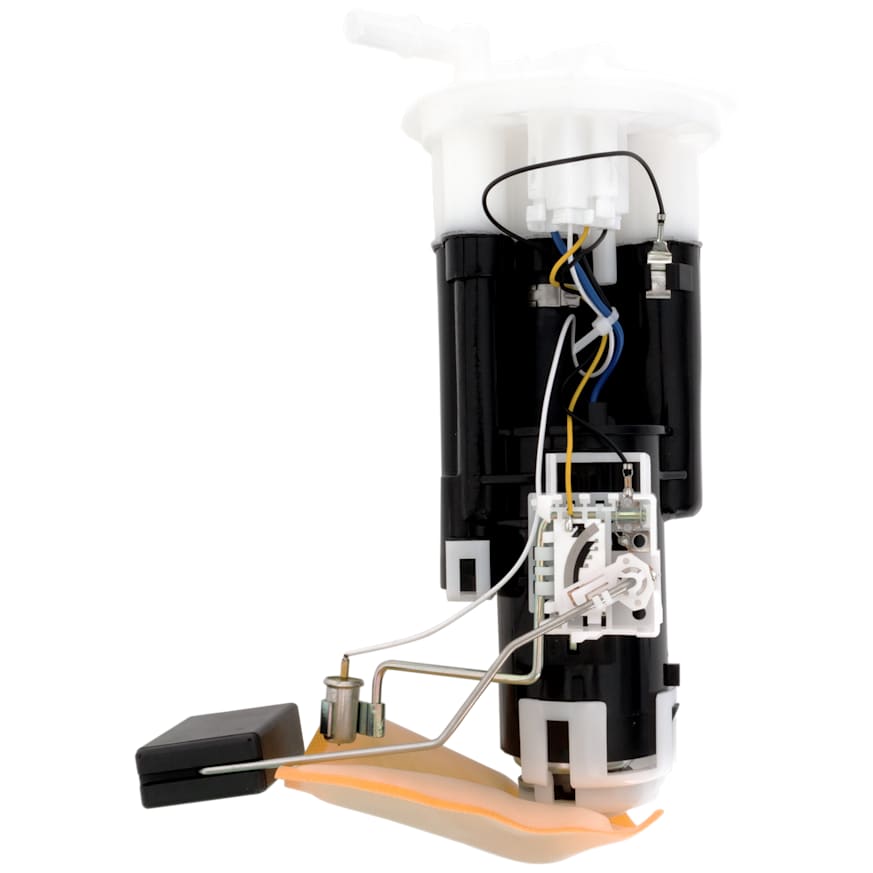Your car has a fuel pump (or sometimes multiple fuel pumps) that helps move fuel from the tank to the injectors at a specific pressure. If the fuel pump isn’t operating properly, the engine either won’t run well or won’t run at all.
As important as the fuel pump is, you might not know where it’s located, especially if you’re new to automotive repair. That’s why we’re here to help you find your car’s fuel pump and learn more about it along the way.
Where is the Fuel Pump Typically Located?
All vehicles with fuel injection have a primary fuel pump that’s typically located in the fuel tank. Modern vehicles with gasoline direct injection (GDI) also have a second pump, which is a high-pressure pump. This second fuel pump is near the fuel rail in the engine compartment.
Is the Fuel Pump Part of the Engine?
The different parts of a fuel pump can be found inside the fuel tank. Despite the huge role the fuel tank plays in powering the engine—thus powering the car—it’s not a part of the engine. Because of this, the fuel pump is not considered a part of the engine.
Parts of a Fuel Pump

Primary (low-pressure) fuel pumps typically come as part of an assembly that includes the fuel level float, level sensor, and related components. The pump portion of the assembly pulls fuel through a filter at the bottom of the tank, then transfers that fuel to the outlet tube, which routes fuel toward the engine.
As the fuel level rises and falls, the fuel level float moves, causing the resistance to change inside the fuel level sensor. That change in resistance alters the fuel level reading on your car’s dashboard.
It’s important to point out that vehicles with a returnless fuel system usually have a fuel pressure regulator built into the fuel pump assembly. With such a design, there is no return line back to the pump assembly because there isn’t an external regulator that routes fuel back to the tank to bleed off pressure.

If your car has a GDI fuel system, the primary (low-pressure) pump supplies fuel to a high-pressure pump at the fuel rail. A typical high-pressure GDI pump has a tappet that rides on the engine’s camshaft lobe.
When the engine is running, the high-pressure pump is driven by the camshaft, and the tappet acts on the pump’s plunger, causing it to compress and pressurize the fuel inside. A pressure control valve installed between the pump’s inlet and outlet manages the fuel pressure output by the pump.
A Closer Look at the Parts of the Fuel Pump
Fuel pumps are as complex as they are necessary. Here are their parts and the role each plays in running your vehicle.
Pressure Regulator
The pressure regulator helps your vehicle maintain consistent pressure levels for your fuel injectors. Keeping the pressure of your car balanced is essential because engines tend to malfunction if the pressure regulator doesn’t do its job.
When the pressure gets too high, the engine will start misfiring. Emissions will also increase as the catalytic converter overheats or takes damage.
On the other hand, when the pressure gets too low, you might experience difficulty starting your car. Vehicle performance will decrease overall, and your car will likely burn more fuel than necessary.
Fuel Level Sender
The fuel level sender measures how much fuel you have left. It’s the part of the car that signals how much fuel is left in the gas tank.

Strainers
Fuel pump strainers catch any dirt, water, and other contaminants. It prevents the fuel pump from getting clogged, protecting it and making sure it lasts as long as possible.
In other words, the strainers are secondary fuel filters that can only be found in the fuel tank. Unlike fuel filters, strainers are made of fine mesh.
Impeller
The impeller, also known as the gerotor, is a special turbine that sucks fuel from the reservoir and sends it to the pump. Without it, a fuel pump cannot draw fuel.
Armature
It’s arguable that the armature is one the most important parts of the fuel pump because of its role in rotating the impeller. It’s what allows the fuel pump to operate and draw fuel from the reservoir and pump it into the engines.
Reservoir
The reservoir is what stores all the usable fuel in your car. While the fuel tank can still run without being topped off, the reservoir must always be full of fuel.
Fortunately, the reservoir will never run out of fuel before the fuel tank does.
Fuel Pump Location Diagram
Are you ready to locate your car’s fuel pump? You’ll typically find the fuel pump located in the fuel tank. If your car has GDI, there will also be a high-pressure fuel pump located near the fuel rail in the engine compartment.

Note: This is a generic location diagram. Consult a repair manual or repair database to determine the exact location of your car’s fuel pump(s).
Tips When Trying to Access the Fuel Pump
Accessing an in-tank fuel pump is easier on some vehicles than it is on others. Some vehicles have a fuel pump access door underneath the rear seat so that you can get to the pump from inside the cabin. But on other vehicles, you need to drop the fuel tank before you can access the pump.
Another tip: If you’re opening the fuel system to access the high-pressure fuel pump, make sure you consult the appropriate service information and relieve system pressure beforehand. Failing to do so can result in severe injury, as direct injection fuel systems are under extreme pressure.
Any information provided on this Website is for informational purposes only and is not intended to replace consultation with a professional mechanic. The accuracy and timeliness of the information may change from the time of publication.































